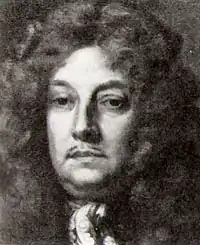Francis Newport, 1st Earl of Bradford
Francis Newport, 1st Earl of Bradford PC (23 February 1620 – 19 September 1708), styled The Honourable between 1642 and 1651, was an English soldier, courtier and Whig politician.

Background
Born at Wroxeter, he was the eldest son of Richard Newport, 1st Baron Newport and his wife Rachel Leveson, daughter of Sir John Leveson (circa 1555 - 1615) and sister of Sir Richard Leveson (1598–1661).[1] His younger brother was Andrew Newport.[2] In 1651, he succeeded his father as baron.[1] Newport was educated at Christ Church, Oxford.[3]
Career
He represented Shrewsbury in both the Short Parliament and Long Parliament.[4] A royalist during the English Civil War, he fought in 1644 in the Battle of Oswestry on the side of King Charles I of England and was then imprisoned.[5] After the restoration in 1660, Newport became Custos Rotulorum of Shropshire, fulfilling this office for his lifetime.[6] In the same year, he had been appointed also Lord Lieutenant of Shropshire,[7] but on the command of King James II of England was replaced by George Jeffreys, 1st Baron Jeffreys in 1687.[8] After Jeffrey's death and the Glorious Revolution in 1689, Newport was restored as Lord Lieutenant until 1704.[7]
Newport was Comptroller of the Household between 1668 and 1672.[9] Subsequently, he was appointed Treasurer of the Household, a post he held a first time until 1686, and three years later again until his death in 1708.[9] Newport was also Cofferer of the Household from 1689 until the death of King William III of England in 1702.[10]
In 1668, he was sworn of the Privy Council of England,[7] expelled in 1679 for his opposition to the government,[11] but readmitted in 1689.[7] On 11 March 1675, he was elevated to the peerage as Viscount Newport, of Bradford, in the County of Shropshire, his main home. On 11 May 1694, he was further honoured when he was created Earl of Bradford.[12]
Family and death

On 28 April 1642, Newport married Lady Diana Russell, fourth daughter of Francis Russell, 4th Earl of Bedford, at St Giles in the Fields, London,[3] and had by her five daughters and four sons.[13]
One daughter, Katherine, married Henry Herbert, 4th Baron Herbert of Chirbury: she left funds on her death in 1716 to endow almshouses in Preston upon the Weald Moors, Shropshire, as a thanksgiving for her rescue when lost on the Alps.[14]
Newport died aged 88 in Twickenham[13] and on his deathbead, he wailed in anguish:
Oh, that I could lie for a thousand years upon the fire that is never quenched, to purchase the favor of God and be united to Him again. But it is a fruitless wish. Millions and millions of years will bring me no nearer the end of my torments than one poor hour. Oh, eternity, eternity forever and forever! Oh, the insufferable pangs of Hell![15]
He was buried in St Andrew's Church, Wroxeter, two weeks later[3] and was succeeded in his titles by his oldest son Richard.[1] His younger son Thomas was raised to the Peerage of England in his own right.[1]
References
- Burke, John (1831). A General and Heraldic Dictionary of the Peerages of England, Ireland, and Scotland. London: Henry Colburn and Richard Bentley. p. 396.
- Henning, Basil Duke (1983). The House of Commons, 1660-1690. vol. I. London: Secker & Warburg. pp. 136–137. ISBN 0-436-19274-8.
- "ThePeerage - Francis Newport, 1st Earl of Bradford". Retrieved 19 November 2006.
- Frederic Madden, Bulkeley Bandinel and John Gough Nichols, ed. (1838). Collectanea Topographica et Genealogica. vol. V. London: John Bowyer Nichols and Son. pp. 292–293.
- "The Twickenham Museum - The Earl of Bradford". Retrieved 13 July 2009.
- "Institute of Historical Research - Custodes Rotulorum 1660-1828". Archived from the original on 23 December 2012. Retrieved 12 July 2009.
- Doyle, James Edmund (1886). The Official Baronage of England. vol. I. London: Longmans, Green & Co. p. 206.
- "Buckinghamshire County Council - 17th century Lords Lieutenant". Retrieved 13 July 2009.
- Haydn, Joseph (1851). The Book of Dignities: Containing Rolls of the Official Personages of the British Empire. London: Longman, Brown, Green and Longman's. pp. 204–205.
- "Loyola University Chicago - The Database of Court Officers 1660-1837" (PDF). Archived from the original (PDF) on 16 March 2009. Retrieved 13 July 2009.
- Thomas, Walter Keith (1978). The Crafting of Absalom and Achitophel. Wilfrid Laurier Univ. Press. pp. 39. ISBN 0-88920-059-9.
- Nicolas, Nicholas Harris (1825). A Synopsis of the Peerage of England. vol. I. London: John Nichols and Son. p. 469.
- Garbet, Samuel (1818). The History of Wem. London: G. Franklin. pp. 103–105.
- Baugh, G C and Elrington C R. "Preston upon the Weald Moors: Charities for the poor Page 183 A History of the County of Shropshire: Volume 11, Telford. Originally published by Victoria County History, London, 1985". British History Online. Retrieved 4 August 2020.
- Zuck, Roy B. (1997). The Speaker's Quote Book. Kregel Publications. p. 124. ISBN 0-8254-4098-X.
| Political offices | ||
|---|---|---|
| Preceded by Sir Thomas Clifford |
Comptroller of the Household 1668–1672 |
Succeeded by The Lord Maynard |
| Preceded by Sir Thomas Clifford |
Treasurer of the Household 1672–1686 |
Succeeded by The Earl of Yarmouth |
| Preceded by The Earl of Yarmouth |
Treasurer of the Household 1689–1708 |
Succeeded by The Earl of Cholmondeley |
| Preceded by Sir Peter Apsley |
Cofferer of the Household 1691–1702 |
Succeeded by Sir Benjamin Bathurst |
| Honorary titles | ||
| English Interregnum | Lord Lieutenant of Shropshire 1668–1672 |
Succeeded by The Lord Jeffreys |
| Custos Rotulorum of Shropshire 1660–1708 |
Succeeded by The 2nd Earl of Bradford | |
| Preceded by The Lord Jeffreys |
Lord Lieutenant of Shropshire 1689–1704 | |
| Peerage of England | ||
| New creation | Earl of Bradford 1694–1708 |
Succeeded by Richard Newport |
| Viscount Newport 1675–1708 | ||
| Preceded by Richard Newport |
Baron Newport 1651–1708 | |